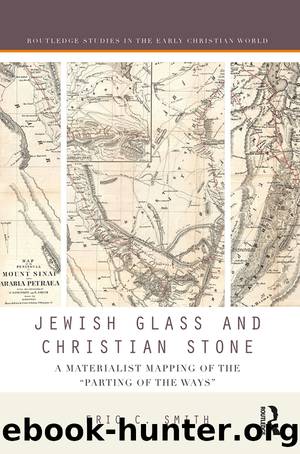Jewish Glass and Christian Stone by Smith Eric C

Author:Smith, Eric C.
Language: eng
Format: epub
Publisher: Taylor & Francis (CAM)
Clay vessels
So far Iâve focused on the oil lamp from Beth Sheâarim, which has decoration that we might call Christian but which was found at a site that fits with what we understand to be Judaism. Itâs an interesting case because itâs an object that seems to be out of place, like the gold glass in the Catacomb of St. Marcellinus and St. Peterâan object bearing the markings of one group found in the space of a different group. But another category of material presents a related but distinct set of questions: objects that display the symbols of both Jewish and Christian traditions. Two such objects, another oil lamp and a seal stamp, along with some related materials, deserve our attention here.
A peculiar oil lamp is described and pictured in a 1964 article by Erwin R. Goodenoughâan article actually mainly devoted to describing the seal stamp to which we will turn our attention shortly.25 The lamp is presented late in the article as a comparandum to the stamp, and Goodenough narrates correspondence with Michael Avi-Yonah about the lamp in question, and includes a photograph of the lamp as his figure 8.26 Goodenough calls the lamp âPalestinianâ and gives no further information about its provenance in this article; in his third volume of Jewish Symbols in the Greco-Roman Period, Goodenough includes a photograph of the lamp.27 The lamp itself is typical of lamps in the period, and not so different from the one bearing the chi-rho from Beth Sheâarim. But this lamp makes prodigious use of its limited space for decoration; it is adorned with an arch on its spout, two columns under that, a seven-branch menorah, a nine-branch menorah, two long palm branches circling the bottom of the lamp, and, on the middle of each side, additional arches, each circling a cross.28 The standout features here are obviously the two menorahs and the two crosses, juxtaposed as they are on a single lamp. In Goodenoughâs short article, he focuses on the spatial arrangement of the crosses and menorahs, seeing the former as subordinate to the latter, and Avi-Yonah agrees with him. The subordination does not appear as clearly to me (on a lamp that is roughly circular, I cannot discern much of a hierarchy in organization), but the very fact of the crossesâ and menorahsâ appearance together is provocative.
Goodenough concludes, as did A. Reifenberg before him, that âJewish Christiansâ must have been responsible for this lamp.29 Noting the geographical and temporal spread of objects exhibiting this kind of mixture of symbolism, Goodenough asks whether âsuch Christianityâ (that is, Jewish Christianity) âwas more widespread and persistent than we had ever supposed.â30 He answers his own question in the negative, albeit cautiously:
I do not think that so large a conclusion is justified, yet the fact of the evidence remains, and seems to me to show unmistakably that at least some Christians, probably many, carried over strictly Jewish symbols into their new faith ⦠Presumably the old Jewish value was given new Christian explanations.
Download
This site does not store any files on its server. We only index and link to content provided by other sites. Please contact the content providers to delete copyright contents if any and email us, we'll remove relevant links or contents immediately.
| Central Africa | East Africa |
| North Africa | Southern Africa |
| West Africa | Algeria |
| Egypt | Ethiopia |
| Kenya | Nigeria |
| South Africa | Sudan |
| Zimbabwe |
Goodbye Paradise(3729)
Men at Arms by Terry Pratchett(2784)
Tobruk by Peter Fitzsimons(2447)
Arabs by Eugene Rogan(2263)
Borders by unknow(2232)
Pirate Alley by Terry McKnight(2187)
Belonging by Unknown(1812)
It's Our Turn to Eat by Michela Wrong(1688)
The Biafra Story by Frederick Forsyth(1616)
Botswana--Culture Smart! by Michael Main(1559)
The Source by James A. Michener(1540)
A Winter in Arabia by Freya Stark(1506)
Coffee: From Bean to Barista by Robert W. Thurston(1489)
Gandhi by Ramachandra Guha(1488)
The Falls by Unknown(1486)
Livingstone by Tim Jeal(1451)
The Shield and The Sword by Ernle Bradford(1369)
Africa: Altered States, Ordinary Miracles by Richard Dowden(1353)
Egyptian Mythology A Fascinating Guide to Understanding the Gods, Goddesses, Monsters, and Mortals (Greek Mythology - Norse Mythology - Egyptian Mythology) by Matt Clayton(1331)
